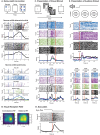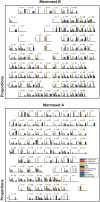Functional specialization and distributed processing across marmoset lateral prefrontal subregions
- PMID: 39390711
- PMCID: PMC11466848
- DOI: 10.1093/cercor/bhae407
Functional specialization and distributed processing across marmoset lateral prefrontal subregions
Abstract
A prominent aspect of primate lateral prefrontal cortex organization is its division into several cytoarchitecturally distinct subregions. Neurophysiological investigations in macaques have provided evidence for the functional specialization of these subregions, but an understanding of the relative representational topography of sensory, social, and cognitive processes within them remains elusive. One explanatory factor is that evidence for functional specialization has been compiled largely from a patchwork of findings across studies, in many animals, and with considerable variation in stimulus sets and tasks. Here, we addressed this by leveraging the common marmoset (Callithrix jacchus) to carry out large-scale neurophysiological mapping of the lateral prefrontal cortex using high-density microelectrode arrays, and a diverse suite of test stimuli including faces, marmoset calls, and spatial working memory task. Task-modulated units and units responsive to visual and auditory stimuli were distributed throughout the lateral prefrontal cortex, while those with saccade-related activity or face-selective responses were restricted to 8aV, 8aD, 10, 46 V, and 47. Neurons with contralateral visual receptive fields were limited to areas 8aV and 8aD. These data reveal a mixed pattern of functional specialization in the lateral prefrontal cortex, in which responses to some stimuli and tasks are distributed broadly across lateral prefrontal cortex subregions, while others are more limited in their representation.
Keywords: auditory; electrophysiology; faces; marmoset; prefrontal cortex; visual; vocalizations; working memory.
© The Author(s) 2024. Published by Oxford University Press.
Figures






Similar articles
-
Short-Term Memory Impairment.2024 Jun 8. In: StatPearls [Internet]. Treasure Island (FL): StatPearls Publishing; 2025 Jan–. 2024 Jun 8. In: StatPearls [Internet]. Treasure Island (FL): StatPearls Publishing; 2025 Jan–. PMID: 31424720 Free Books & Documents.
-
Inactivation of Dorsolateral Prefrontal Cortex During Auditory Working Memory.J Integr Neurosci. 2025 Jul 30;24(7):38877. doi: 10.31083/JIN38877. J Integr Neurosci. 2025. PMID: 40767011
-
Prescription of Controlled Substances: Benefits and Risks.2025 Jul 6. In: StatPearls [Internet]. Treasure Island (FL): StatPearls Publishing; 2025 Jan–. 2025 Jul 6. In: StatPearls [Internet]. Treasure Island (FL): StatPearls Publishing; 2025 Jan–. PMID: 30726003 Free Books & Documents.
-
The Black Book of Psychotropic Dosing and Monitoring.Psychopharmacol Bull. 2024 Jul 8;54(3):8-59. Psychopharmacol Bull. 2024. PMID: 38993656 Free PMC article. Review.
-
Factors that influence parents' and informal caregivers' views and practices regarding routine childhood vaccination: a qualitative evidence synthesis.Cochrane Database Syst Rev. 2021 Oct 27;10(10):CD013265. doi: 10.1002/14651858.CD013265.pub2. Cochrane Database Syst Rev. 2021. PMID: 34706066 Free PMC article.
References
-
- Ainsworth M, Sallet J, Joly O, Kyriazis D, Kriegeskorte N, Duncan J, Schüffelgen U, Rushworth MFS, Bell AH. Viewing ambiguous social interactions increases functional connectivity between frontal and temporal nodes of the social brain. J Neurosci. 2021:41:6070–6086. 10.1523/JNEUROSCI.0870-20.2021. - DOI - PMC - PubMed
Publication types
MeSH terms
Grants and funding
LinkOut - more resources
Full Text Sources

